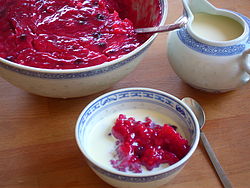Rødgrød
 | |
| Place of origin | Denmark and Germany |
|---|---|
| Main ingredients | Potato starch, red summer berries, black cherries, sugar |
Rødgrød (Danish: [ˈʁœðˀˌkʁœðˀ] (![]() listen)), Rote Grütze (German: [ˈʁoːtə ˈɡʁʏtsə] (
listen)), Rote Grütze (German: [ˈʁoːtə ˈɡʁʏtsə] (![]() listen)), or Rode Grütt (Low Saxon: [ˈroʊdə ˈɡrʏt] (
listen)), or Rode Grütt (Low Saxon: [ˈroʊdə ˈɡrʏt] (![]() listen)), meaning "red groats", is a sweet fruit dish from Denmark and Northern Germany. The name of the dish in Danish features many of the elements that make Danish pronunciation difficult for non-native speakers, so
listen)), meaning "red groats", is a sweet fruit dish from Denmark and Northern Germany. The name of the dish in Danish features many of the elements that make Danish pronunciation difficult for non-native speakers, so ![]() rødgrød med fløde, literally "red porridge with cream", is a commonly used shibboleth since the early 1900s.[1][2]
rødgrød med fløde, literally "red porridge with cream", is a commonly used shibboleth since the early 1900s.[1][2]
Traditional preparation[]

Rødgrød or Rote Grütze was traditionally made of groat or grit, as revealed by the second component of the name in Danish, German, or Low German.[3][4]
Semolina and sago are used in some family recipes; potato starch is today the standard choice to achieve a creamy to pudding-like starch gelatinization. The essential ingredients that justify the adjective are red summer berries such as redcurrant, blackcurrant, raspberries, strawberries, blackberries, bilberries and stoned black cherries.[5] The essential flavour can be achieved with redcurrant alone; a small amount of blackcurrant will add variety; sugar is used to intensify the flavour. The amounts of starch, sago, semolina differ with the solidity desired; 20 to 60 grams on a kilogram or liter of the recipe are usual; sago, groat or grit have to soak before they can be used.[5]
The preparation is basically that of a pudding: The fruits are cooked briefly with sugar. The mass should cool down for a moment so that the starch—dissolved in fruit juice or water—can be stirred into it without clumping. A second cooking process of one to two minutes is needed to start the gelatinization; remaining streaks of white starch have to clear up in this process.[5]
Rødgrød or Rote Grütze is served hot or cold as a dessert with milk, a mixture of milk and vanilla sugar, , (whipped) cream, vanilla ice cream, or custard to balance the refreshing taste of the fruit acids.[6]
Variants[]

There are several modern variants of rødgrød, sold basically in German supermarkets: grüne Grütze, the green variant, is made from gooseberries and rhubarb in combination with kiwifruit and apples. In Denmark, a similar dish is known as stikkelsbærgrød (gooseberry jelly).[7] To make blaue Grütze, the blue variant, blackberries, bilberries, plums, blackcurrant, and grapes are usually used. Gelbe Grütze consists of peaches, yellow gooseberries, bananas, gold kiwifruit, or other yellow fruits.
In Poland, parts of Russia, the Baltic states, Finland, and Ukraine, kissel is known as a dessert similar to rødgrød.[8]
In the US Virgin Islands—formerly the Danish West Indies before the US purchased the islands in 1917—it is known as "red grout" and is made with tapioca, guava, and sugar, served with a custard sauce. [9]
In Southern Brazil, sagu is a popular dessert made with tapioca pearls, sugar and red wine, mainly appreciated by Italian- and German-origin families.[10]
See also[]
- Danish cuisine
- Fruit kissel
- List of fruit dishes
- List of porridges
- List of shibboleths
References[]
- ^ Notes and Queries, April 4th, 1903, Volume XI, "Rödgröt med Flöde" on page 269.
- ^ Brian Lennon: Passwords: Philology, Security, Authentication. Section on "rødgrød med fløde." Harvard University Press, 2018. ISBN 978-0674980761.
- ^ Dictionary entry "Grütze"
- ^ Dictionary entry "Grütt"
- ^ Jump up to: a b c Darra Goldstein: Fire and Ice: Classic Nordic Cooking, Ten Speed Press, 2015. ISBN 978-1607746102.
- ^ Johann Lafer; Johann Lafer - Das Beste: Die besten Rezepte aus über 40 Jahren Küchenpraxis, page 375, Gräfe und Unzer, 2017. ISBN 978-3833864100.
- ^ Carol Gold: Danish Cookbooks: Domesticity & National Identity, 1616-1901, Seattle, University of Washington Press, 2007. ISBN 978-0295986821.
- ^ Peter Vatrooshkin: Easier Than a Steamed Turnip: Simple and Delicious Meatless Russian Recipes, Plutagora, 2012, page 103.
- ^ "Food and Recipes | US Virgin Islands".
- ^ "Sagu – Traditional Dessert From Brazil". TasteAtlas. Retrieved 28 June 2019.
External links[]
- Danish desserts
- Porridges
- German desserts
- North German cuisine
- Schleswig-Holstein cuisine
- Hamburg cuisine
- Fruit dishes